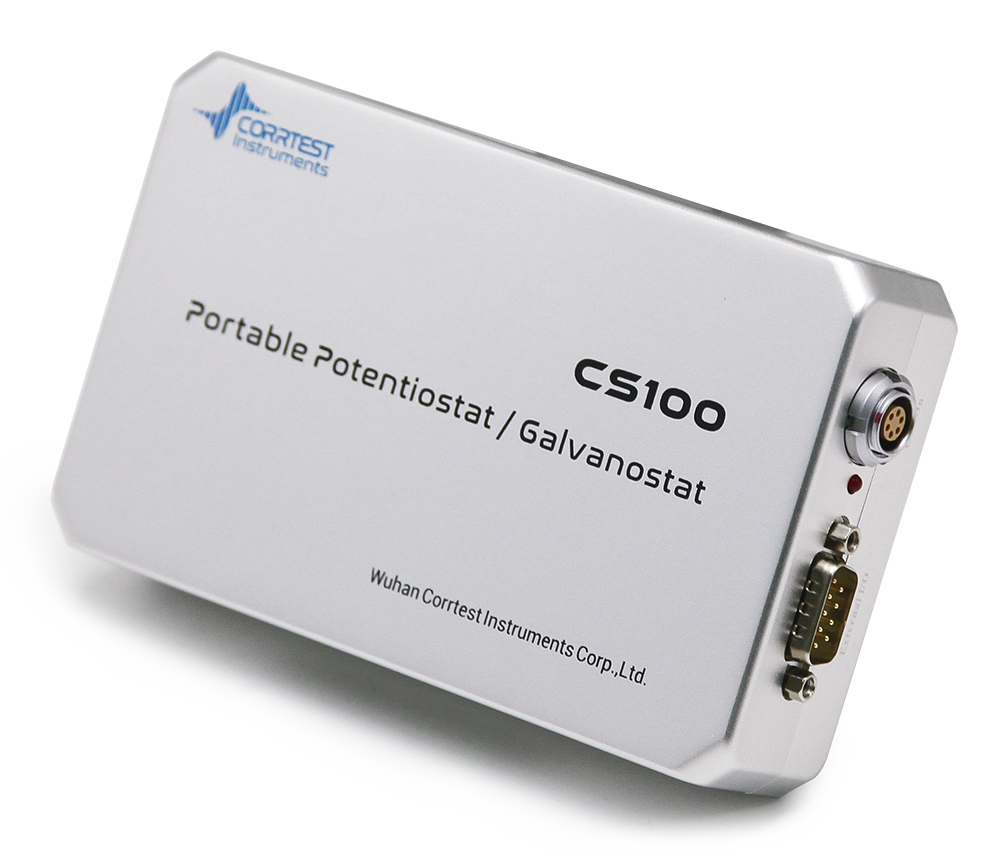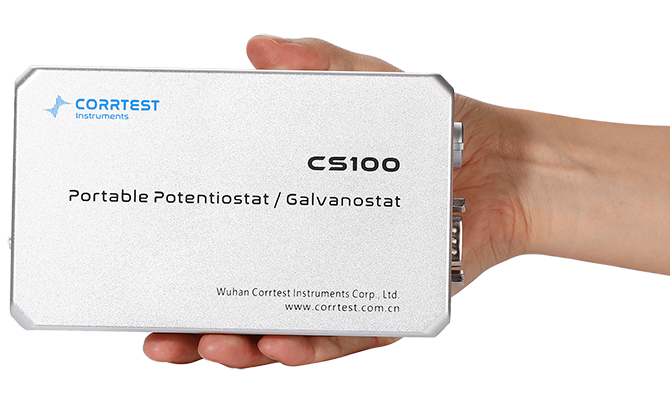Product Introduction
CS100ME handheld potentiostat supports full electrochemical methods, including potentiostatic/galvanostatic polarization curve, Cyclic voltammetry analysis, impedance(EIS), and galvanic current measurement. etc. It has built-in chargeable li-ion battery and Bluetooth communication. The device supports laptop/computer software or mobile APP. It can be used for electrochemical tests in field or special non-electricity environment. CS100ME can be a convenient handheld tool for researchers of energy& materials, environment protection, biosensor, foods &drugs, corrosion protection etc. Maximum current is ±100mA The voltage control range is ±10V, compliance voltage is ±10V, the maximum current output is ±100mA, and the minimum current resolution can reach 1pA. The EIS frequency range is 10μHz~1MHz.

Features
- Small & light, handheld and convenient
- Easy to install and use
- High accuracy, current resolution can reach to 1pA, and measurement accuracy is 0.1% of the range.
-during outdoor test, a laptop’s USB port can be used for both charging and communicating
- The circuit adopts floating design. Electrochemical parameters of the grounded system can be measured without an isolation transformer.

Thanks to its small size with comprehensive electrochemical functions, it’s typically used for:
- Battery materials’ performance test in a glove box
- Ultra-low detection limit of heavy metal ions for water quality test in environmental protection field
- Low current detection in biosensor thanks to high current accuracy
- Effective ingredients detection in food and drug industry
- Outdoor bridge corrosion and soil corrosion measurements
Note: maximum current during experiment doesn’t exceed ±100mA then the handheld potentiostat can be used. If exceeds ±100mA an ordinary size potentiostat with maximum current ±2A should be considered.
Specifications
Specifications
Size / weight:15 x 9 x 3 (cm), 500g
Communication: USB / Bluetooth
Power supply: USB / built-in Li-ion battery 10AH@3.7V
Support 2-, 3-or 4-electrode system
Maximum current: ± 100mA
Potential control range: ±10V
EIS frequency range: 10μHz ~ 1MHz
Compliance voltage: ±10V
Current range: 200pA~200mA, 10 ranges
Potential range:±200mV ±2V, ±5V, ±10V
Potential accuracy: 0.1%× full range
Minimum potential resolution: 1mV
Current accuracy: 0.1%× full range
Minimum current resolution: 1pA
Reference electrode input impedance: 1013Ω||8pF
AC amplitude: 0~±2.5V
Signal response bandwidth: 1MHz
Max. acquisition rate: 150,000 data points/s
CV and LSV scan rate: 0.001mV~ 10V/s
Techniques
Electrochemical techniques - CS100ME
Stable polarization
· Open Circuit Potential (OCP)
· Potentiostatic (I-T curve)
· Galvanostatic
· Potentiodynamic (Tafel plot)
· Galvanodynamic (DGP)
Transient Polarization
· Multi Potential Steps
· Multi Current Steps
· Potential Stair-Step (VSTEP)
· Galvanic Stair-Step (ISTEP)
Chrono Method
· Chronopotentiometry (CP)
· Chronoamperometry (CA)
· Chronocaulometry (CC)
Voltammetry
·Linear Sweep Voltammetry (LSV)
· Cylic Voltammetry (CV)
· Staircase Voltammetry (SCV) #
· Square Wave Voltammetry (SWV) #
· Differential Pulse Voltammetry (DPV) #
· Normal Pulse Voltammetry (NPV)#
· Differential Normal Pulse Voltammetry (DNPV) #
· AC Voltammetry (ACV)
· 2nd harmonic AC Voltammetry (SHACV)
· Fourier Transform AC Voltammetry (FTACV)
# there is correspinding Stripping Voltammetry
Electrochemical Impedance Spectroscopy (EIS)
· Potentiostatic EIS (Nyquist, Bode)
· Galvanostatic EIS
· Potentiostatic EIS (Optional freq.)
· Galvanostatic EIS(Optional freq.)
· Mott-Schottky
· Potentiostatic EIS vs. Time (Single freq.)
· Galvanostatic EIS vs. Time (Single freq.)
Corrosion Measurements
· Potentiodynamic (Tafel plot)
· Cyclic polarization curve (CPP)
· Linear polarization curve (LPR)
· Electrochemical Potentiokinetic Reactivation (EPR)
· Electrochemical Noise (ECN)
· Zero resistance Ammeter (ZRA)
Battery test
· Battery Charge and Discharge
· Galvanostatic Charge and Discharge (GCD)
· Potentiostatic Charging and Discharging(PCD)
· Potentiostatic Intermittent Titration Technique(PITT)
· Galvanostatic Intermittent Titration Technique(GITT)









 Contact Us
Contact Us +86 13469965984
+86 13469965984